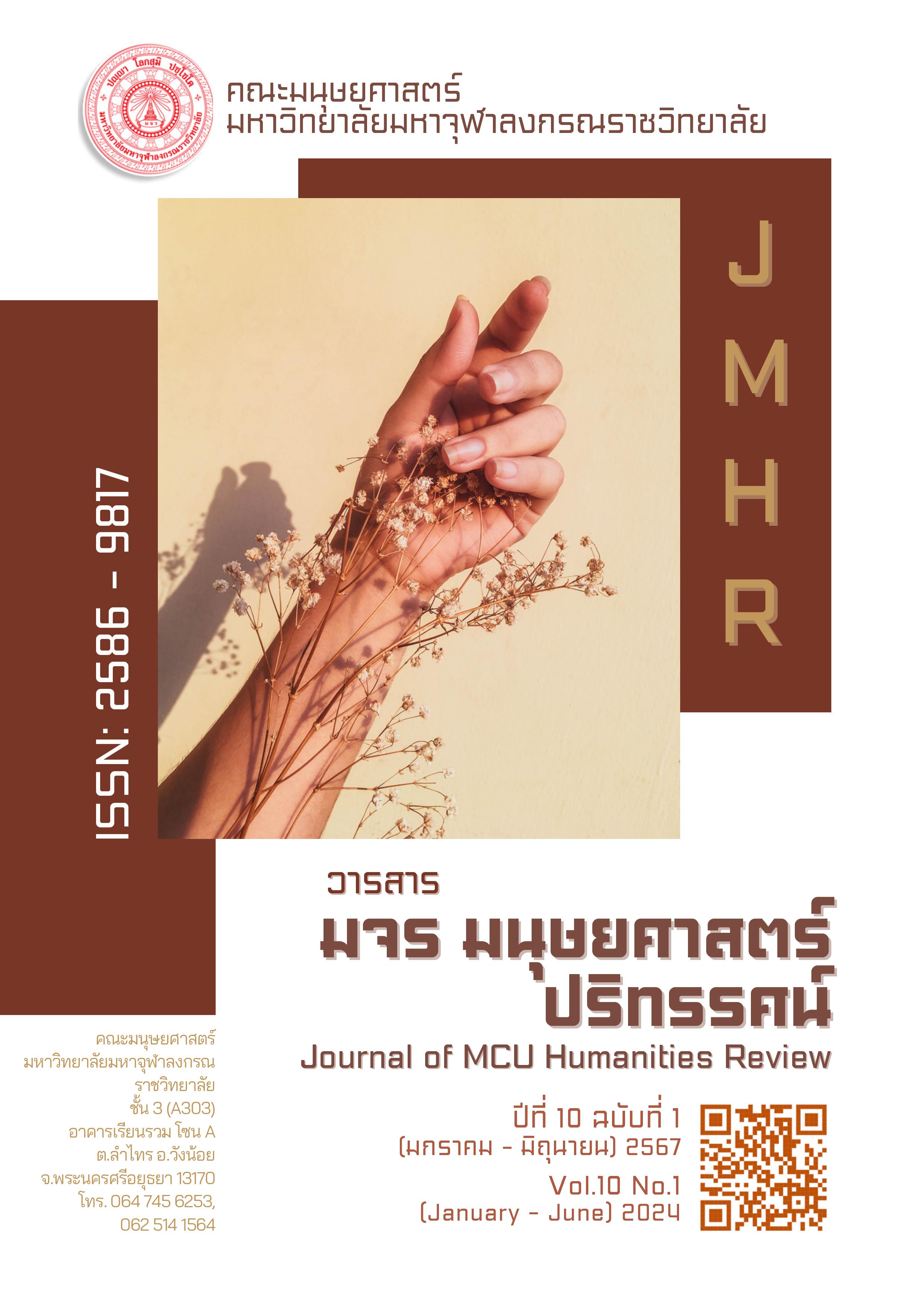การพัฒนาแบบทดสอบออนไลน์วัดบุคลิกภาพด้านจริต 6 ตามแนวพุทธศาสนา
คำสำคัญ:
การพัฒนา, ออนไลน์, แบบทดสอบ, บุคลิกภาพ, จริต 6, พุทธศาสนาบทคัดย่อ
การวิจัยนี้มีวัตถุประสงค์ 1. เพื่อสร้างแบบทดสอบออนไลน์บุคลิกภาพด้านจริต 6 และ 2. เพื่อพัฒนาหาคุณภาพของแบบทดสอบที่สร้างขึ้นและสร้างตะแนนมาตรฐาน T สำหรับจำแนกจริต 6 พัฒนาแบบทดสอบจากลักษณะนิสัยและพฤติกรรมของแต่ละจริต สร้างเป็นข้อคำถาม ผ่านการตรวจสอบด้วยผู้ทรงคุณวุฒิจำนวน 5 ท่านเพื่อคำนวณหาค่าความถูกต้องตามเนื้อหาด้วยค่าดัชนีค่าสัมประสิทธิ์ความสอดคล้องและวัดความคงที่ภายในด้วยวิธีการหาสัมประสิทธิ์แอลฟาของครอนบาค ได้เครื่องมือแบบประเมินบุคลิกภาพจริต 6 มีจำนวน 64 ข้อ นำเครื่องมือที่ได้ทำเป็นออนไลน์ ประชากรของงานวิจัยนี้ เป็นกลุ่มบุคคลที่มีสามารถอ่านภาษาไทยได้และสามารถเข้าถึงอินเทอร์เนตได้ กลุ่มตัวอย่างเป็นบุคคลผู้ที่มีความสนใจที่จะรู้จักตนเองและสามารถเข้าถึงอินเทอร์เนตได้ในเขตกรุงเทพ ปริมณฑล และเขตเมือง เครื่องมือแบบทดสอบออนไลน์วัดบุคลิกภาพจริต 6 ที่ได้ไปสำรวจด้วยวิธีการที่ผู้วิจัยกระจายให้กับผู้รู้จักเพื่อให้นำไปกระจายต่อใปในเครือข่ายผ่านสื่อออนไลน์ (Virtua snowball sampling) ได้กลุ่มผู้ตอบแบบทดสอบทั้งหมด 654 คนจากสูตรคำนวณขนาดของกลุ่มตัวอย่างของทาโร ยามาเน โปรแกรม Excel และ PSPP นำมาใช่ในการคำนวณทางสถิติ คำนวณหาสถิติพรรณนา คำนวณหาค่าเฉลี่ยเลขคณิต ส่วนเบี่ยงเบนมาตรฐาน คะแนนมาตรฐาน Z (Z score) และคะแนนมาตรฐาน T (T score) ใช้คะแนนมาตรฐาน (T-score) สูงสุดจากคะแนนจริตทั้ง 6 ด้านเป็นตัวระบุจริตของบุคคลนำเสนอออกมาในรูปแผนภูมิแท่งตามคะแนนมาตรฐานที ผลการดำเนินการวิจัยบรรลุวัตถุประสงค์ที่ได้เครื่องมือเป็นแบบทดสอบออนไลน์วัดบุคลิกภาพจริต 6 ที่สามารถระบุจริตเด่นของบุคคลและจริตทั้ง 6 ด้านโดยแสดงออกมาในรูปของกราฟแท่ง
เอกสารอ้างอิง
บุญรัตน์ แผลงศร. (2565). เครื่องมือการวิจัยทางสังคมศาสตร์: แบบสอบถามออนไลน์. วารสารการวัดผลการศึกษา. 39(105), 28-38.
ปภังกร เทพพิทักษ์. (2565). แนวคิดประโยชน์นิยมและหลักคุณธรรม 12 ประการของมหาวิทยาลัยทางจิตของโลกกับแนวทางการสร้างประโยชน์. วารสารนวัตกรรมสังคมและเทคโนโลยีสื่อสารมวลชน, 5(1), 28-36.
ปิ่น มุทุกันต์. (2499). พุทธวิธีครองใจคน (พิมพ์ครั้งที่ 2). กรุงเทพฯ : สำนักพิมพ์คลังวิทยา.
พ. รัตนลักษณ์. (2552). ศาสตร์แห่งการอ่านใจคน จริต จริยา 6. นนทบุรี: อุทยานความรู้.
พระครูกัลยาสิทธิวัฒน์ (สมาน พรหมอยู่/กัลยาณธัมโม). (2549). เอตทัคคะในพระพุทธศาสนา (พิมพ์ครั้งที่ 9). กรุงเทพฯ : โรงพิมพ์ บริษัท สหธรรมิก.
พระจินดา ฉนฺทธมฺโม (สามี). (2559). ศึกษาราคจริตในการปฏิบัติวิปัสสนาภาวนาในพุทธศาสนาเถรวาท (วิทยานิพนธ์พุทธศาสตรมหาบัณฑิต). มหาวิทยาลัยมหาจุฬาลงกรณราชวิทยาลัย. พระนครศรีอยุธยา.
พระมหาอนันต์ อนุตฺตโร, บุญร่วม คําเมืองแสน และ พระมหาพจน์ สุวโจ. (2564). การปฏิบัติกรรมฐานเพื่อบําบัดความเครียด. วารสารมนุษยศาสตร์และสังคมศาสตร์ มหาวิทยาลัยเอเชียอาคเนย์. 5(2), 329-342.
พระศรีวรญาณ (วิ) (2542). เก็บเพชรจากคัมภีร์พระไตรปิฎก. กรุงเทพฯ: โรงพิมพ์มหาจุฬาลงกรณราชวิทยาลัย.
พระสรพงณ์ ปญฺาธโร (จุลละโพธิ). (2561). การศึกษาบุคลิกภาพตามแนวจริต 6 ของนิสิตคณะพุทธศาสตร์ มหาวิทยาลัยมหาจุฬาลงกรณราชวิทยาลัย ห้องเรียนวัดไชยชุมพลชนะสงคราม จังหวัดกาญจนบุรี (วิทยานิพนธ์พุทธศาสตรมหาบัณฑิต). มหาวิทยาลัยมหาจุฬาลงกรณราชวิทยาลัย. พระนครศรีอยุธยา.
มหาจุฬาลงกรณราชวิทยาลัย. (1539). พระไตรปิฎกภาษาไทย ฉบับมหาจุฬาลงกรณราชวิทยาลัย. กรุงเทพฯ : โรงพิมพ์มหาจุฬาลงกรณราชวิทยาลัย.
โย่ง ศรีเวียน. (2561). การพัฒนาแบบประเมินเจตสิกปัจจัยเชิงทำนายบุคลิกภาพของผู้ปฏิบัติธรรม (วิทยานิพนธ์พุทธศาสตรดุษฎีบัณฑิต). มหาวิทยาลัยมหาจุฬาลงกรณราชวิทยาลัย. พระนครศรีอยุธยา.
ล้วน สายยศ และ อังคณา สายยศ. (2553). เทคนิคการวิจัยทางการศึกษา (พิมพ์ครั้งที่ 11). กรุงเทพฯ : สุวีริยาสาส์น.
อนุวัติ คูณแก้ว. (2562). การวัดผลและประเมินผลการศึกษาแนวโหม่. ฉบับปรับปรุงใหม่ล่าสุด (พิมพ์ครั้งที่ 3). กรุงเทพฯ : สำนักพิมพ์จุฬาลงกรณ์มหาวิทยาลัย.
อนุสร จันทพันธ์ และ บุญชัย โกศลธนากุล. (2546). จริต 6 ศาสตร์ในการอ่านใจคน. กรุงเทพฯ: อมรินทร์พริ้นติ้งแอนด์พับลิชชิ่ง.
Chiv, Chanmeardey. (2561). การพัฒนาแบบสารวจบุคลิกภาพของนักเรียนระดับมัธยมศึกษาตอนปลายในเขตพัฒนาพิเศษภาคตะวันออก: การวิเคราะห์กลุ่มพหุ. (วิทยานิพนธ์วิทยาศาสตรมหาบัณฑิต). มหาวิทยาลัยบรูพา. ชลบุรี.
Dosek T. (2021). Snowball Sampling and Facebook: How Social Media Can Help Access Hard-to-Reach Populations. PS: Political Science & Politics. 54(4), 651-655.
Grau, E. (2007). Using Factor Analysis and Cronbach’s Alpha to Ascertain Relationships Between Questions of a Dietary Behavior Questionnaire. In JSM Proceedings, Survey Research Methods Section. Alexandria, VA: American Statistical Association. Retrieved May 20, 2024, From http://www.asasrms.org/Proceedings/y2007/Files/JSM2007-000505.pdf
Nayak, M.S. & Narayan, K.A. (2019). Strengths and weakness of online survey. IOSR Journal of Humanities and Social Sciences. 24(5), 31-38.
Nunnally. J. C. (1978). Psychometric theory (2nd ed.). New York: McGraw-Hill.uctory Analysis. 3rd ed. New York: Harper & Row Publisher, Inc.
ดาวน์โหลด
เผยแพร่แล้ว
รูปแบบการอ้างอิง
ฉบับ
ประเภทบทความ
หมวดหมู่
สัญญาอนุญาต
ลิขสิทธิ์ (c) 2024 วารสาร มจร มนุษยศาสตร์ปริทรรศน์

อนุญาตภายใต้เงื่อนไข Creative Commons Attribution-NonCommercial-NoDerivatives 4.0 International License.






